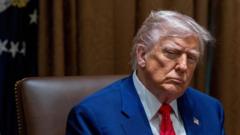After a tumultuous week in the realm of global trade, President Donald Trump’s ambitious tariff strategy is now navigating uncertain waters. Last week, Trump unveiled an extensive tariff plan designed to revolutionize America’s trading landscape, imposing a sweeping 10% tariff on nations far and wide, and additional “reciprocal” tariffs on 60 countries labeled as blatant economic offenders. This bold move sent shockwaves through international markets, but just days later, the president announced a 90-day hold on these higher tariffs for most countries, complicating the future trajectory of his economic agenda.
Let’s break down five vital objectives of Trump’s trade initiatives and assess their current viability:
1) **Negotiating Better Trade Agreements:** Trump has long argued that the U.S. has been exploited by foreign nations. The initial strong stance has garnered attention: over 75 world leaders reportedly reached out to propose trade concessions. Negotiations with key allies like South Korea and Japan are in the works, but time is of the essence as countries have just 90 days to secure favorable terms.
2) **Revitalizing U.S. Manufacturing:** Trump emphasized the importance of reshoring jobs to bolster American production. Yet, the erratic nature of recent tariff announcements may deter companies from investing decisively in U.S. manufacturing, leaving many to wait for clearer trade policies before making commitments.
3) **Confronting China Head-On:** Framing China as the principal culprit behind the U.S.'s trade issues, Trump’s confrontation has risks. While some officials express optimism about the potential for a resolution, the current trade skirmish could alienate U.S. allies during this pivotal economic strife.
4) **Increasing Government Revenue:** Trump previously projected that tariffs could significantly boost U.S. revenue, potentially generating $2 trillion over the next decade. However, as tariffs remain in limbo, the anticipated fiscal windfall could shift if trade dynamics change.
5) **Lowering Consumer Prices:** Trump’s promise of reduced costs for American buyers could backfire. While some analysts speculate lower energy prices post-tariff announcement, a consensus remains that the tariffs are likely leading to increased consumer prices. The Tax Foundation warns about the direct financial impact on households, particularly among lower-income Americans.
In conclusion, while Trump’s trade aspirations are currently in stasis, the ripple effects of his decisions continue to influence the global economic landscape. With his administration’s aggressive stance facing scrutiny, many are left wondering how this will reshape America's economic relationships moving forward.





















